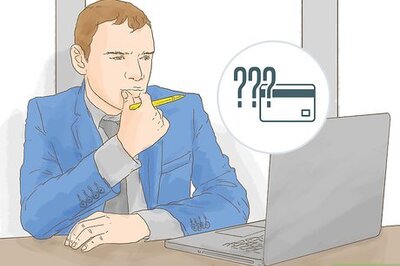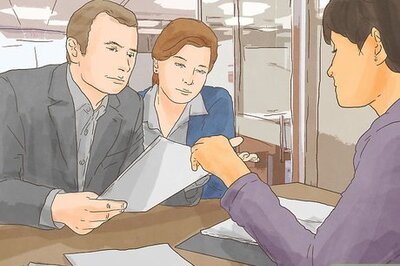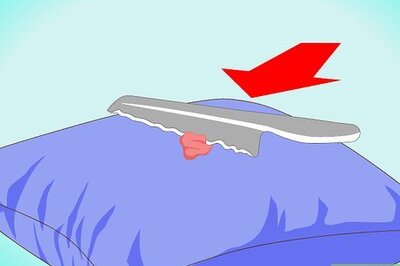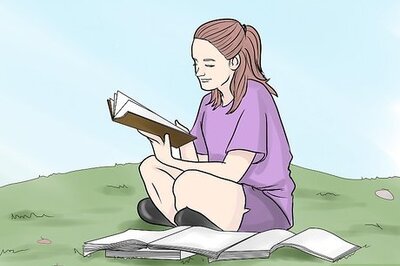
views
How to Fix Your Gamer Posture
Chair Height: so your thighs are parallel to the ground Sit all the way back in your seat. If your feet dangle in the air or if your thighs are angled down, lower your seat. If your thighs are lifted off the seat when your feet are on the ground, then raise the seat height. Adjust your chair using the height control lever on the side or bottom of the seat.
Hip Position: pushed back into your seat and tilted forward When you’re sitting, scoot all the way back in your chair so you’re against the backrest. Bowe adds “the best thing you can do is…tip your hips forward and put a little bit of arch in your [lower] back” so you’re in a better, more comfortable position. The gap between the back of your knees and the front of your chair’s seat should be about the width of 3 fingers. If the distance is shorter, then the seat is too deep. Check if your chair allows you to adjust the tilt of the seat until you have a larger enough gap.
Leg Position: knees bent to 90 degrees and feet flat on the floor Oyanagi says that you want to keep your feet completely planted on the ground while you’re sitting in your chair. She also mentions to keep your knees bent at 90 degrees so they’re directly above your feet. If your feet do not reach the floor or if your knees are not at 90 degrees, use an under-desk foot rest for additional support.
Back Position: straight and against your chair’s backrest With your hips angled forward and pushed back into the seat, lean your upper body into backrest to keep your spine supported while you’re gaming. Adjust your chair’s lumbar support to fit the arch in your back. If your chair doesn’t have a lumbar support, Bowe says a rolled-up towel works well to support your arch. EXPERT TIP Claire Bowe, M.Ed., PT, Cert. MDT Claire Bowe, M.Ed., PT, Cert. MDT Physical Therapist Claire Bowe is a Physical Therapist and the Owner of Rose Physical Therapy Group, a physical therapy clinic based in Washington D.C. Claire has over 20 years of patient care experience and specializes in a personalized, one-on-one therapeutic approach to physical therapy. Claire is certified in Mechanical Diagnosis & Therapy (MDT) by the McKenzie Institute and is an Ergonomic Assessment Specialist under the United States Occupational Health and Safety Administration (OSHA). She holds an M.Ed. in Special Education from Portland State University, an MA in Physical Therapy from Governors State University, and a BS from Oregon State University. Claire Bowe, M.Ed., PT, Cert. MDT Claire Bowe, M.Ed., PT, Cert. MDT Physical Therapist Try to have the same amount of arch in your back that you have standing. When you're standing, feel the arch in the small of your back with your hands. When you sit, try to maintain that same arch with the chair's lumbar support.
Shoulder Position: relaxed and pulled back Keep your shoulders in a neutral position instead of leaning forward and rounding them. To get into a neutral position, shrug your shoulders as high as you can and then roll them backwards. Then, relax your shoulders to bring them to the proper position.
Desk Height: above your thighs so your forearm rests flat on the surface Make sure that the bottom of the desk clears the tops of your legs when you scoot your chair in. If you have an adjustable desk, raise or lower the surface so your forearms are flat and parallel to the floor. When your desk is at the proper height and your forearms are parallel to the floor, you can move your mouse around faster so aiming in a game is easier.
Arm Position: close to your body and elbows bent at 90 degrees Bowe says that keeping your elbows at your sides and bent at 90 degrees helps prevent arm pain when you’re at a computer. In the proper position, she mentions that you should not have to raise your arms or bend unnaturally to reach something on your desk. If your chair has arm rests, make sure they’re in a position that keep your elbows bent at 90 degrees and your shoulders in a neutral position. If your arm rests are too tall, then they’ll raise your shoulder and cause discomfort.
Wrist Position: straight in a neutral position Oyanagi makes it clear that your “wrists should be neutral [and] should not be in an extended position or flexed position.” Make sure your wrists are straight and in line with your forearms. If your wrists bend or flex when you place them on your desk, then rest them on wrist supports to keep them straight.
Neck and Head Position: straight over your spine Leaning with your head tilted forward puts a lot of extra strain on your neck and back. While you’re sitting in your chair, look straight ahead and tuck your chin back to straighten out your neck. If your ears are directly above your shoulders, then you’re in the right position. It’s okay if this position feels unnatural at first. Try to hold it for a few minutes at first, and increase the time as it starts to feel more comfortable. Use a gaming headset so you don’t have to lean forward to talk into a mic when you’re gaming with friends.
Monitor Position: arm’s length away and the top at eye level Hold your arm straight out in front of you and place your monitor right in front of your fingertips, or about 20–30 inches (51–76 cm) away. Raise or lower the monitor so your eyes line up with the top third of the screen when you’re sitting up straight. Place a few books or a stand under your monitor if you need to raise it higher. Alternatively, attach it to a monitor arm so it’s easily adjustable.
Keyboard and Mouse Position: within reach without leaning or extending Bowe says to “[keep] your keyboard and your mouse within an easy reaching distance.” She mentions that you shouldn't have to reach far out to get to your mouse, and you should easily be able to move your elbow in a windshield motion to use it. Overextending or reaching for your keyboard and mouse can make you lean forward and limit your range of motion when you’re trying to game.
Benefits of Good Gaming Posture
Improved mood and energy When you’re slouching, you’re more likely to have negative thoughts, but sitting up straight makes you feel better and more confident. When you have more energy, you’ll be more alert while you’re gaming so you’ll be able to react quicker and make more impressive plays.
Improved range of motion Because you’re in a more comfortable position, you won’t strain when you move your mouse around or reach for the key you need to press. That quicker motions means you’ll be able to easily maneuver around in your game without a lot of effort.
Less joint and muscle pain When you’re slouched or sitting with bad posture, you’re bending and flexing, and that puts a lot of stress on your joints and muscles. Sitting with the proper posture means everything is aligned and in a neutral position, so you’ll feel less of those aches and pains later on.
Strengthened core muscles Sitting up straight actually engages your abs and your other core muscles, so it’s almost like a mini-workout while you’re gaming. As you continue using good posture, you’ll feel a lot more stable and balanced too.
Fewer headaches Tightness in your neck, shoulders, and back from bad posture can sometimes lead to painful tension headaches. When you’re sitting up straight and supporting your body with good posture, all that tension goes away so you can focus on your game again.
Reduced chances of injury When your body is in an awkward position, repetitive or awkward motions while you’re gaming may cause lifelong injuries over time. If you maintain the correct gamer posture, you’re less likely to develop painful conditions that could limit your range of motion.
Risks of Bad Gaming Posture
Bad gaming posture puts a lot of strain on your body. Holding your body in an uncomfortable position for long periods of time can make you feel stiff and achy when you finish gaming. When you continue using bad gaming posture, it may actually weaken your body and lead to lifelong discomfort. Some common risks of bad posture include: Eye strain and fatigue Tension headaches Neck and back pain Gamer’s thumb Hand cramps Carpal tunnel syndrome Tendonitis Rounded or hunched shoulders Forward head posture Degenerative disc disease Muscle weakness and imbalances Deep vein thrombosis
Gamer Posture FAQs
What is gaming posture? Gaming posture is how you position your body while playing video games. Normally, you’ll sit down at a desk or on the couch while you’re gaming. When you’re really focused and locked in on a game, it’s pretty common to forget about maintaining proper posture, so you’ll start to slouch, lean closer to the screen, or tilt your head forward.
How can you improve posture for mobile gaming? When you’re playing games on your phone, sit up straight and hold your phone at eye level so you aren’t bending your neck forward. Place a pillow under your forearms for additional support and to keep your phone in an upright, angled position. Alternatively, use a phone stand to hold your phone if you’re using a controller to play games.
How do you choose an ergonomic gaming chair? When you’re looking for an ergonomic gaming chair, first check that you feel comfortable when you’re sitting down and that you have about ⁄2 inch (1.3 cm) between the front of the seat and the backs of your knees. Make sure that your feet sit flat on the floor when you’re sitting down, and that your back feels fully supported when you lean against the backrest. Some other features to look for in a gaming chair include: Adjustable seat height Adjustable lumbar support Arm rests A five-pedestal base Built-in foot rests Seat tilt
How to Relieve Pain from Bad Gaming Posture
Stretch your joints and muscles. Stretching helps release tension from your body and can relieve tightness from sitting with bad posture. Add stretches into your daily routine or whenever you take a break between games. Some great stretches to try include: Chin tucks: Move your head backwards to tuck your chin in and hold the position for 5 seconds. Trap stretches: Sit straight up and hold the bottom of the seat with one hand. Place your other hand on your head and pull your head toward your shoulder. Hold the position for 10 seconds before relaxing and switching sides. Shoulder rolls: Move your shoulders forwards in a circular motion. After a couple forward rolls, switch directions to move your shoulders backwards. Lower back stretch: Sit in your chair and bend forward at the hips until your hands touch the floor. Hold the position for 10 seconds before sitting up again.
Take frequent breaks. Oyanagi says, “Try to move every 30 minutes, whether you can just stand up or stretch a little.” She continues, “Do not stay in a static position. Periodically do a little bit of exercise, gentle stretching, or a little bit of breathing exercise” Bowe mentions, “Good posture doesn't mean one perfect position all day.” She continues that it’s reasonable to shift your position and weight, and then come back to the proper posture for the majority of the time.
Take pain relievers for immediate relief. If the pain is bothering you, choose an over-the-counter pain reliever and take it following the directions on the package. The medication will help soothe aches and pains temporarily so you can feel comfortable for the rest of the day. Pain relievers are a temporary solution and will not treat the underlying cause. If you’re feeling chronic pain, then address the issue by correcting your posture
Wear a posture corrector temporarily. Posture correctors are straps that wrap around your upper body to keep you in the proper position. Try wearing a posture corrector for a little while to get the feeling of how you’re supposed to keep your back and shoulders. Posture correctors are not a long-term solution and they may actually weaken your muscles if you use them for prolonged periods of time. Only use them to learn the proper posture, and they try keeping your body in that position without one.




















Comments
0 comment